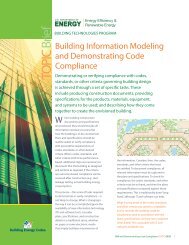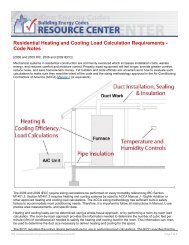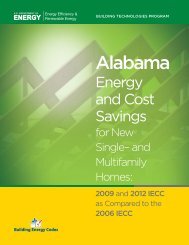Texas - Building Energy Codes
Texas - Building Energy Codes
Texas - Building Energy Codes
You also want an ePaper? Increase the reach of your titles
YUMPU automatically turns print PDFs into web optimized ePapers that Google loves.
While exemptions or allowances in the code in are not included in this analysis, the code does allow for some of<br />
these depending on the compliance path. Examples include the following:<br />
• One door and 15 ft 2 of window area are exempt<br />
• Skylight U-factors are allowed to be higher than window U-factors<br />
• Five hundred square feet or 20% of ceiling area of a cathedral ceiling, whichever is less, is allowed to<br />
have R-30 insulation in climate zones where more than R-30 is required for other ceilings<br />
Incremental First Costs<br />
Table A.6 shows the costs of implementing the prescriptive measures of the new code. Costs are provided for<br />
both the reference home and apartment/condo moving from the 2009 to the 2012 IECC. The costs derive from<br />
estimates assembled by Faithful + Gould (2012) and a number of other sources. 2 The original cost data were<br />
based on a national average. The costs are adjusted downwards by 16.3% (multiplied by 0.837) to reflect local<br />
construction costs based on location factors provided by Faithful + Gould (2011).<br />
Table A.6.<br />
Total Construction Cost Increase for the 2012 IECC Compared to the 2009 IECC<br />
2,400 ft 2 House 1,200 ft 2 Apartment/Condo<br />
2A $1,670 $819<br />
2B $1,670 $819<br />
3A – North of warm humid $2,116 $979<br />
3A – Warm humid $2,116 $979<br />
3B $2,116 $979<br />
4 $1,704 $843<br />
Results<br />
Life-Cycle Cost<br />
Table A.7 shows the LCC savings (discounted present value) of the new code over the 30-year analysis period.<br />
These savings assume that initial costs are mortgaged, that homeowners take advantage of the mortgage<br />
interest tax deductions, and that efficiency measures retain a residual value at the end of the 30 years. As<br />
shown in Table A.7, life-cycle cost savings averaged across climate zones are $3,456 for the 2012 IECC.<br />
Table A.7.<br />
Life-Cycle Cost Savings Compared to the 2009 IECC<br />
Code Zone 2A Zone 2B<br />
Zone 3A – North<br />
of Warm Humid<br />
Zone 3A –<br />
Warm<br />
Humid<br />
Zone 3B Zone 4 State Average<br />
2012 IECC $2,505 $2,828 $5,485 $5,662 $3,886 $6,118 $3,456<br />
2 The Faithful + Gould cost data and other cost data for energy efficiency measures are available on the “BC3” website at<br />
http://bc3.pnnl.gov/.<br />
A.6 April 2012
















